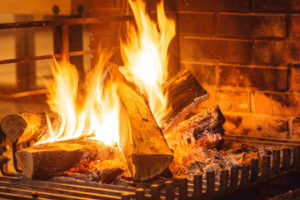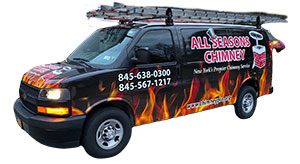As we head into the coldest time of the year here in the Hudson Valley, it is important to know how to get the most your fireplace to keep your family as cozy and warm as possible this winter. For over 25 years, All Seasons Chimney has provided the region with superior professional chimney maintenance, repair, and installation services, and one of our top priorities is teaching our customers how to operate their fireplaces as safely and efficiently as possible. Our team of professionals is certified by industry leaders, such as the Chimney Safety Institute of America (CSIA) and the National Fireplace Institute (NFI), and during our training and certification courses, we have learned the best practices for just about every aspect of chimney and fireplace systems. This includes how to increase the heating efficiency in your home by burning longer, cleaner, and hotter fires. We would like to take this opportunity to share with you some wood burning tips that will help you maximize your fireplace this winter.
 Only burn seasoned firewood.
Only burn seasoned firewood.
When wood is freshly cut, it can have a moisture content as high as 45 percent. Wet, or green, wood can be difficult to ignite, and when you do finally get a fire going with it, the fire must use up most of its energy-burning off the water before it can produce any heat. This results in an overproduction of smoke, corrosive vapors, and creosote, and this creates deadly hazards, such as chimney fires and carbon monoxide leaks. To avoid these risks, All Seasons Chimney recommends that you only burn seasoned firewood in your fireplace. This type of firewood has been allowed to dry for at least six months after being cut. If you do not cut your own firewood, you can find seasoned firewood at reputable dealers. According to the CSIA, properly seasoned firewood is lightweight, grayish in color, and be cracked and split on the ends. If you knock two pieces of wood together, you should hear a hollow sound if the wood has been seasoned. Green wood would make a dull thudding sound. You can also use a digital moisture meter to make sure that the firewood is only 20 to 25 percent water. Once you have purchased your firewood supply, it is important to store it off the ground so that it does not reabsorb any moisture. We recommend you place your firewood on pallets, concrete blocks, or gravel if you do not have a storage shed.
Use the upside-down method to build a top-down burn.
If you struggle to get a fire going, it might have to do with the method you used to build it. Many of us learned how to build a fire using the log cabin style, where the kindling is placed at the very bottom, but the leading experts at the CSIA have found that a better method of building a fire is to do the exact opposite and put the kindling at the top. Known as the top-down method, this technique has been used for centuries to build fires in the large masonry heaters across Europe. You will begin by placing your largest pieces of firewood across the bottom of your fireplace or stove and then continue layering about four or five rows of logs on top of that first layer. Make sure that each row is made up of smaller logs than the last row. Once you have the wood stacked to about half of the height of the fireplace, you should start to layer your kindling on top of the stack of logs. Be careful not to stack your kindling higher than the fireplace opening. You will then light the very top of your kindling with a single match, and as it burns, it will keep igniting the wood below. This “light it and you’re done” procedure allows you to relax and enjoy the fire with your family and friends instead of worrying about adjusting logs in the fireplace to keep the flames going.
Have your chimney professionally swept and inspected at least once a year.
When you burn wood, creosote develops naturally during the combustion process and builds up on the interior walls of your chimney over the winter. Although you can greatly reduce the amount of creosote that is produced by only using seasoned firewood when using your fireplace, your chimney needs to be professionally swept every year. The CSIA has named creosote as a leading cause of chimney fires because it is highly flammable. When All Seasons Chimney sweeps your chimney, we take great care to remove every bit of creosote to reduce the risk of chimney fires. You can trust our CSIA-certified chimney sweeps to make sure that your fireplace is safe to use every winter.
Have you had your chimney professionally swept and inspected this year? Contact us today at All Seasons Chimney to schedule your appointment for our professional chimney maintenance services. We are here for all of your professional chimney maintenance, repair, and installation needs.

